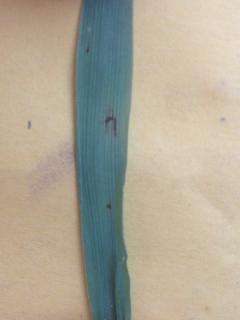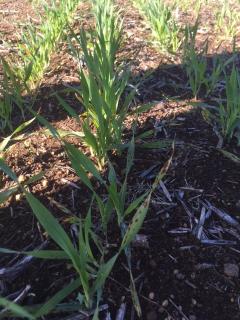Net blotches found in barley crop and volunteers
- Wongan Hills
- Corrigin
- Frankland River
- Kojaneerup
Plant pathologist Jason Bradley (DPIRD) has found net-type net blotch (NTNB) in Baudin barley regrowth near Wongan Hills.
Michael Macpherson (Imtrade) reports finding spot-type net blotch (STNB) in volunteer barley east of Corrigin.
Laura Archer (Elders) reports finding STNB in Planet barley seedlings that were sown mid-May at Frankland River. The paddock was in canola last year and Granger barley the year before. The crop sown with Hombre Ultra® which does not protect against net blotches.
Plant pathologist Kithsiri Jayasena (DPIRD) recently found STNB in Rosalind barley regrowth at Kojaneerup.
Net blotches being found on barley volunteers or regrowth is a good indicator that conditions are ripe for net blotches and that barley on barley seedlings are at risk of infection.
Both STNB and NTNB are stubble borne diseases, the fungus is carried from season to season on infested stubble. The closer new crops are sown to stubble, the greater the risk of infection occurring at early growth stages.
STNB lesions develop as small circular or oval dark brown spots with yellow edges.
Infections can occur following around six hours of leaf wetness at temperatures between 10-25°C. Primary inoculum comes from airborne spores, which are produced on stubbles from previous crops. Risk of infection in seedling to tillering growth stages is greatest in barley regrowth and continuous barley which are exposed to infected barley stubble.
STNB occurs state-wide but is most damaging in south coastal and neighboring medium to high rainfall regions where it can have severe yield and quality effects.
NTNB lesions appear on leaves as thin brown streaks or blotches that may enlarge up to several centimetres in length. Darker longitudinal and horizontal lines sometimes develop in the lesions, creating a net like appearance.
NTNB infection and spread is favoured by wet conditions and it is most evident following periods of rainfall. It will cause the greatest yield loss in paddocks that are re-sown to barley without a break-crop as the fungus is stubble borne, carried from season to season on infected barley stubbles. Spores produced on stubble are spread by wind to initiate infections in new barley crops. Seed infection is rare and is considered of minor importance in spreading disease.
Barley varieties that are susceptible to STNB or NTNB that have not been treated with a registered seed dressing against net blotches (ie Systiva® or Uniform®) and are sown into in a high risk situation (barley on barley) are particularly vulnerable. To see which barley varieties are susceptible to STNB and NTNB refer to DPIRD’s 2019 barley variety sowing guide for Western Australia.
Growers with significantly higher levels of NTNB disease infection are also encouraged to collect plant samples before they are sprayed and send them to the department to aid identification and assist research to learn more about this new pathotype. Growers sending samples with suspected NTNB to the department can contact DPIRD technical officer Simon Rogers on +61 (0)8 9368 3445.
Managing net blotches and being mindful of resistance
Applying a fungicide spray is necessary in medium to high rainfall regions where disease threatens crops with high yield and quality expectations, particularly if the barley crop has been sown into or adjacent to last year’s barley stubble.
Application of a registered foliar fungicide prior to stem extension (for example, tillering) can reduce disease levels but may still require a follow-up fungicide later in the season. In low rainfall areas fungicide applications are most likely to result in a yield response to STNB when the disease pressure is high and there is reasonable spring rainfall or stored soil moisture.
The choice of a single-spray or two-spray strategy depends on the environment in which the crop is growing. In high rainfall environments it may be necessary to apply two sprays, such as at early stem elongation stage with a follow-up spray three to four weeks later.
While in medium rainfall regions, consider one well timed spray between late stem elongation and early flag leaf emergence (Z33 - 39) to protect leaf 2 (flag-1). Under high disease pressure, best results may be obtained by using the maximum recommended rates.
Details on which foliar fungicide active ingredients are registered for STNB and NTNB can be found at DPIRD's Registered foliar fungicides for cereals in Western Australia.
Fungicide resistance to DeMethylation Inhibitor (DMI) fungicides (Group 3 or DMI), such as tebuconazole and propiconazole, has been identified in samples of STNB and NTNB taken from WA’s lower Great Southern and Esperance regions. For more information see the Centre for Crop and Disease Management's (CCDM) Spot form of net blotch debuts on the fungicide resistance list article.
If you suspect fungicide resistance in your paddock please contact the CCDM's fungicide resistance team at frg@curtin.edu.au or phone +61 (0)8 9266 4818.
To prevent further development of fungicide resistance it is recommended that growers; rotate fungicide modes of action, avoid using the same mode of action twice per season, use fungicide mixtures with more than one mode of action and use appropriate label rates. It is also recommended that tebuconazole is not used as a stand-alone product, in barley for any disease.
For further information on symptoms and management of blotches see DPIRD’s Managing spot type net blotch in continuous barley and Managing net-type net blotch of barley in Western Australia pages.
For more information contact Kithsiri Jayasena, Plant Pathologist, Albany on +61 (0)8 9892 8477, Geoff Thomas, Plant Pathologist, South Perth on +61 (0)8 9368 3262, Andrea Hills, Plant Pathologist, Esperance on +61 (0)8 9083 1144 or Ciara Beard, Plant Pathologist, Geraldton on +61 (0)8 9956 8504.


